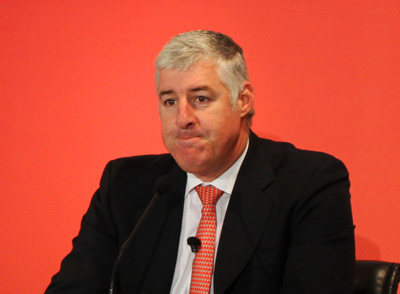NAB promises core banking Xmas present

Customers can expect to see progress in the National Australia Bank's (NAB) core banking overhaul within the next six months, according to CEO Cameron Clyne.

NAB CEO Cameron Clyne (Credit: Luke Hopewell/ZDNet Australia)
"A component of our core banking application will be in the market by the end of this year," Clyne said at a press conference this afternoon.
NAB's next-generation platform project, started back in 2008, is designed to revamp an aging core infrastructure set to cost the bank around $1 billion over the next five years. In the last two years, NAB launched its low cost personal banking initiative, using a branchless online and telephone model called UBank and selected Oracle as a transformation partner.
Clyne today offered no hints as to what customers and shareholders can expect for the new platform development.
In what was a tech-heavy six months for NAB, the bank poured an additional $127 million into infrastructure projects.
"This was mainly driven by the Group's Next Generation Banking IT Platform investment and the transformational and convergence of key technology and operational infrastructure," the bank said.
NAB also expects to have completed its network modernisation project by year's end, and said that it is nearing completion on its contact centre voice infrastructure and mortgage platform transformation projects.
Clyne added that he isn't worried about comparisons between NAB and its rivals such as the Commonwealth Bank with its $1.1 billion project.
The Commonwealth Bank is already well into its core banking transformation, with an emphasis on creating an environment that supports real-time transactions. Meanwhile, Westpac is 18 months into its own projects, burning cash on new customer-facing systems and planning a core re-platforming in 2014.
"Everyone gets excited about drawing comparisons between where people are going and who's first, who's last. We don't proclaim to be first, but we're by no means last in re-platforming that's for sure," Clyne said.
NAB has been competing with other banks on another front in the last six months: hiring staff. The bank has beefed up its full-time equivalent staff numbers in the last six months to support its core banking modernisation program at a cost of $103 million. Rival bank Westpac added 482 heads to its technology ranks alone over the last six months.
Technology outages
Following this morning's Westpac outage due to air-conditioning complications at the bank's datacentre, the question of NAB's outage prevention efforts were on the minds of investors and journalists alike.
Clyne said that technology outages like its recent account balance and transaction slow-downs are the result of a 40-year-old infrastructure that the bank is quickly trying to change.
"Outages and things are the result of an aging environment. We're fixing that, we're definitely on the path to fix it," he promised.
Bizarrely, Clyne said that the bank's recent outages had sparked customer compliment letters like he'd never seen, adding that he doesn't feel NAB was properly recognised for how it communicated to customers.
"Very rarely in banking do you get compliment letters … but we got compliment letters off the back of these technology outages because the branches were open.
"What we weren't given substantial credit for is that we managed to keep people informed on how they can access things," Clyne said, adding that customers are more understanding about outages than they're given credit for.
"Customers realise that things happen in big companies, it's how you deal with it [that counts]," he added.
Clyne assured journalists attending the conference that NAB had checked its air-conditioning systems to prevent a Westpac-style EFTPOS outage.
"Do you feel hot in here?" Clyne joked.
NAB posted a very healthy half-yearly profit figure of $2.4 billion.